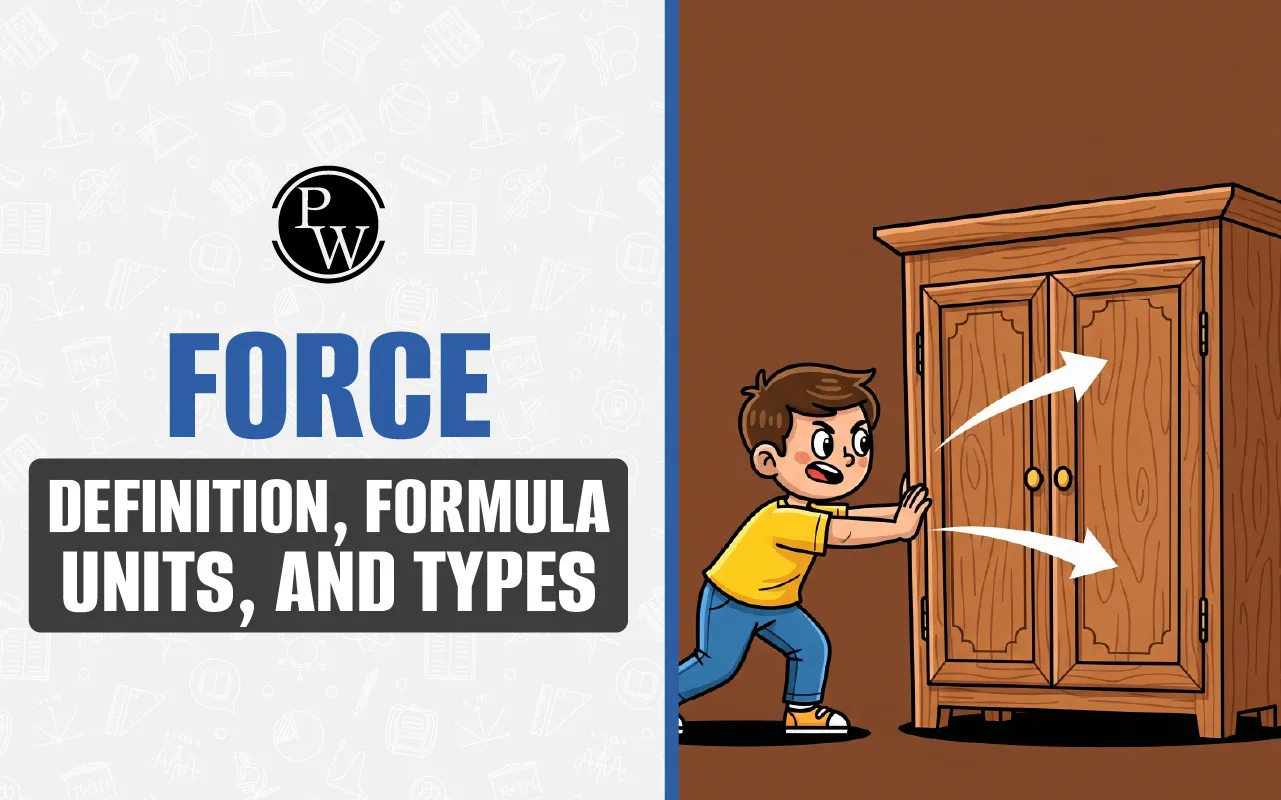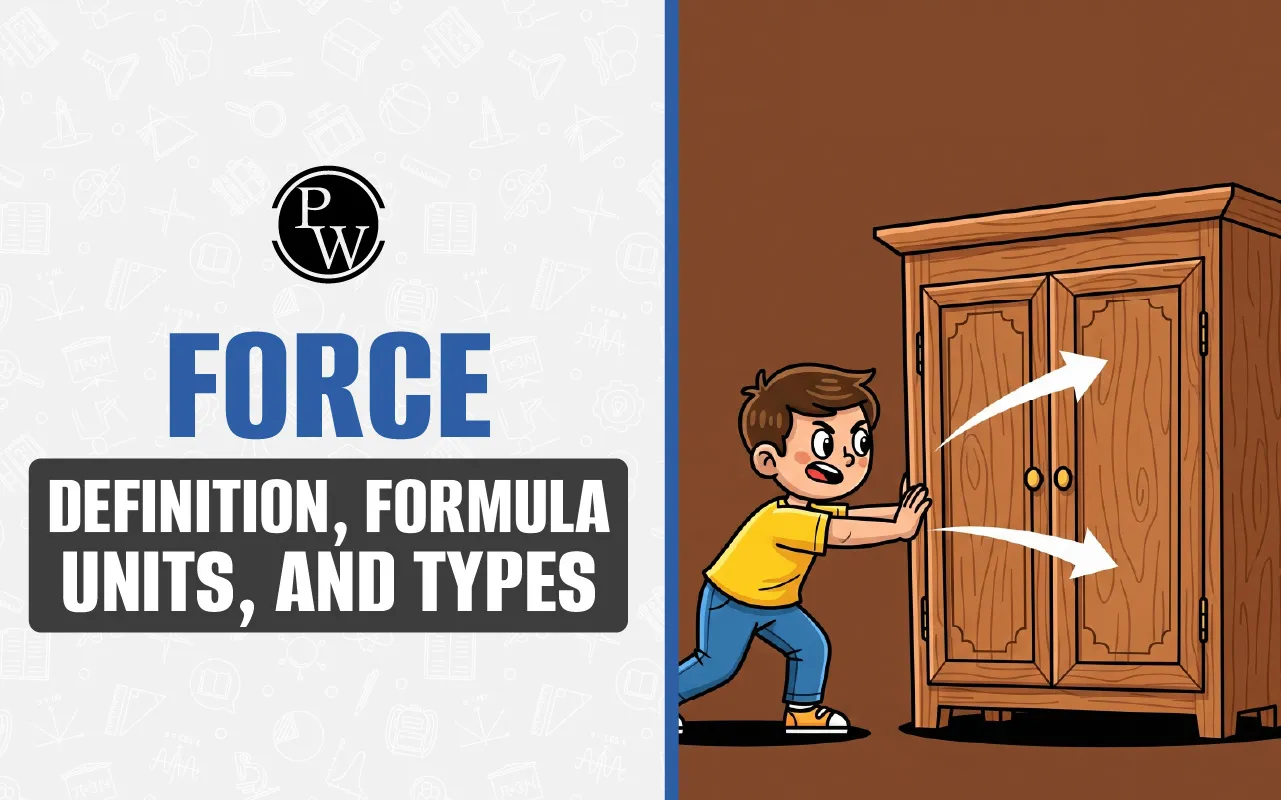

Force is used everywhere in our daily lives, helping us to carry out various activities. You observe that some effort is required when throwing a ball, pedalling a cycle, or lifting your school bag.
It is the force you apply to make things move. From a scientific perspective, force is an important element that helps explain several real-life scenarios. Let's understand the concept of force to recognise how it works to make things change their conditions.
Read More: Freezing and Melting
What is a Force?
Force is applied when you push or pull an object to move it, bring it to rest, or change its condition, velocity, or direction. So, we can define force in relation to an object's motion.
Force has both magnitude and direction that’s why it is called a vector quantity. The magnitude indicates the strength of the force, and the direction tells us in which direction the force is applied. We can only experience the effect of force that helps us measure its magnitude and direction.
Unit of Force
The force is measurable using the units of force. The standard unit of force is the Newton (N) in the SI system and the Dyne (dyn) in the CGS system. They are defined as follows:
-
Newton: It is the force applied on a body of mass 1 kg and causes its velocity change (acceleration) by 1 m/s2. It is denoted by N.
So, we can write: 1 N = 1 kg x 1 m/s2
-
Dyne: It is the force required to move an object with a mass of 1 gram at an acceleration of 1 cm/s2
So, we can write: 1 dyne = 1 g x 1 cm/s2
Dyne and Newton are related to one another. The conversion factor of newton and dyne is as follows:
I N = 105 Dyne
1 Dyne = 10-5 Newton
Formula of Force
Force is an external cause applied to a body to impact its motion. This concept gives the formula for force which says that:
Force is the product of the mass and acceleration of an object.
So, the force formula can be expressed as, F = m x a
Here,
F = Force applied
m = mass of the object
a = acceleration of the object
Solved Example:
How much force is required to accelerate an object of 40 kg at 3 m/s2?
Solution:
Here, m = 40 kg and a = 3 m/s2
Therefore,
F = ma
= 40 × 3
= 120 N
Read More: Structure of Atom
Balanced and Unbalanced Force
Force can be applied on a body from two opposite directions. If the magnitudes of both forces are the same, the net force acting on the object is zero which means there will be no change in the motion or condition of the object. These forces are called balanced forces.
Again, if one of the forces applied to a body is of a higher magnitude than the other force acting in the opposite direction, the difference between these forces is that the net force acts on the body. It causes the body to change its position or condition. These forces are unbalanced.
A simple example can explain it. When you push a heavy box resting on the floor, it may not move initially. When you apply more force, you can make it move.
It happens because the applied force is initially balanced by the frictional force of the floor, which acts in the opposite direction. As you push further, your force becomes more than the frictional force, and the box starts moving.
Read More: Friction
Types of Forces
There are various types of forces acting around us. We can classify forces into two broad groups as follows:
-
Contact Force
-
Non-Contact Force
Let's explain these forces in detail.
Contact Force
This force acts when there is a physical contact between two objects or surfaces. The contact force can be of various types, as mentioned below:
Frictional Force
This force acts when an object is rolling, sliding, or dragging over a surface. It works in the opposite direction of movement. For example, while walking or driving, the frictional force of the road prevents slipping or skidding.
Muscular Force
It is the force that we exert using the muscles of our body. Using this force, we can lift, pull, push, throw, or bend any object. This force often comes into action when overcoming an opposing force. For example, in a tug of war, the team that applies greater muscular force drags the opponent toward them.
Spring Force
This force applied by a compressed or stretched spring is called the spring force. When we apply force on the spring to change its shape or condition, it stores some energy, which manifests as the spring force. It helps make something move or perform actions.
Read More: Different Types of Materials
Non-Contact Forces
The force that acts between objects which are not in contact. There are different types of non-contact forces, as mentioned below:
Gravitational Force
The Earth's gravitational force, which is pulling every object towards the centre of the Earth, is an example of a non-contact force. It is the universal force of attraction that surrounds us everywhere. We can stand, walk, sit, play, move, and do many other activities due to the presence of this force.
Magnetic Force
The force a magnet exerts to attract magnetic materials is called the magnetic force, which acts without contact. It arises as a consequence of electromagnetism. This force comes into action in calling bells, speakers, and magnetic compasses.
Electrostatic Force
This force acts between two static charged bodies which are not in contact. They can be attractive or repulsive, depending on the nature of the charges.
Normal Force
It is a kind of force that acts on the object placed on a surface. It acts normal or perpendicular to the object in the opposite direction of the gravitational force. For example, when a bag is placed on a table, the force of gravity acts on it downward and the normal force acts on it upward.
Read More: What is Temperature?
Effect of Forces
The force applied on an object can result in different effects. Let’s explain the effect of forces through practical examples of force:
Force can make an object at rest start moving
-
You pedal the cycle to start moving
-
You throw a ball over a distance
-
You kick a football keeping on the ground
Force can put a moving object at rest
-
A moving car is stopped by applying brakes
-
A fielder stops a moving cricket ball
-
A goalkeeper holds the moving football
Force can change the velocity of a moving object
-
Increase in velocity of a vehicle by pressing the accelerator
-
Decrease in velocity of a vehicle by changing gears
-
A rolling body comes to rest due to frictional force
Force can change the direction of moving object
-
A footballer passes the ball to another player
-
A batter applies force to change the direction of the cricket ballA car driver operates the steering wheel to change direction
Force can change the shape of an object
-
An inflated balloon in pressed by force
-
Force applied on dough to make roti
-
A spring is compressed or stretched
Laws Related to Force and Motion
In Physics, there are three primary laws that describe how force and motion are inter-related. These are known as Newton’s law of Motion. The three laws are mentioned as follows:
Newton’s First Law of Motion
It states that a static object will remain still and a moving object will keep moving at the same velocity unless an external force is applied on it.
The law indicates that any object has the tendency to resist its change in motion, which gives the concept of inertia.
Newton’s Second Law of Motion
This law states that the acceleration of a moving object is directly proportional to the net force applied on it and inversely proportional to its mass.
This law supports the expression F = m x a, where F is the force, m is the mass, and a is the acceleration.
Newton’s Third Law of Motion
This law states that for every applied force (action) there is an equal and opposite force (reaction).
It means when an object applies a force on another object, the second object also exerts a force of equal magnitude on the first object.
Force and Inertia
We have observed that if we apply the same force to kick a football and a stone of the same size, the football will move to a distance whereas the stone will hardly move.
It is because the mass of the stone is much more than the football. This incident indicates the objects of higher mass resists the change of motion to a greater extent. This property is called inertia. It is proportional to the mass of an object.
Also read: Reflection of Light
How is Newton's First Law and Second law of Motion Related?
According to the second law of motion, Force(F) = mass(m) x acceleration(a). Again, we know that the acceleration of an object is its rate of change of velocity.
If the velocity of an object changes from u to v over a time t, then a = (v-u)/t
In other words, F = m(v-u)/t
Or, Ft = m (v -u)
For F = 0, v = u, whatever be the time. It implies that the object continues to move with the same velocity when there is no force acting on it.
Again if F = 0 and u = 0, then v = 0, which means the object will remain at rest in absence of any force.
Force is a very important and useful concept in science. Understanding the definition, types, and working principles of force helps us identify the reasons behind many practical incidents we observe around us. The relationships between force, motion, and mass give us a clear idea on how to apply, measure, and control the forces acting on different objects.
Make Science Learning More Engaging with CuriousJr Online Classes
If you are concerned that your child lacks interest in science lessons, struggles to learn new concepts, or falls behind in assignments, CuriousJr is here to help. Our online classes kids make science learning a fun experience through interactive and engaging teaching methods.
Key Advantages:
-
Our daily live sessions focus on making science concepts simple and relatable through visual aids and practical examples.
-
Every child gets personalized attention from dedicated mentors who guide them to understand tough topics and resolve doubts.
-
Experienced mentors evaluate every child’s learning needs, abilities, and strengths to tailor the teaching methods for effective outcomes.
-
Regular progress tracking and feedback keep parents informed and help students focus on areas of improvement.
CuriousJr’s tuition programs are designed for students from 3rd to 8th standard, aiming to make education practical, interesting, and child-friendly. Book a demo class to allow your child to explore the science topics with more curiosity and enthusiasm.
Force FAQ
Can displacement happen without any force?
Does gravitational force cause acceleration?
How are force and momentum related?
Does air provide any force?













